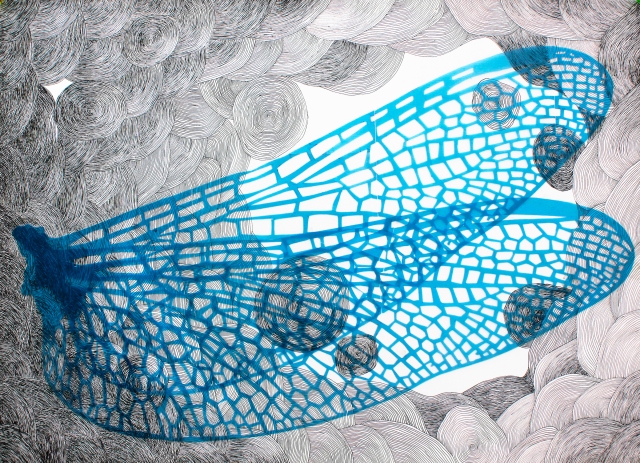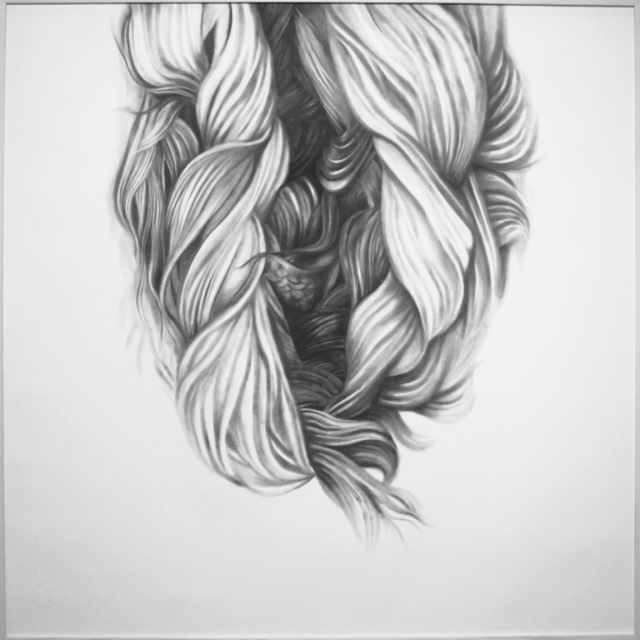By Subhra Mazumdar
The current exhibition of artist Ritu Kamath at the Lalit Kala Akademi, gives viewers a charming opportunity at cherry picking. Though a solo showing, it has distinct categories of exhibits all of them supported by a considerable body of work, enabling the viewer a chance to express choices. A triple treat for the art connoisseur, titled ‘i-seek’ examines the show unveiled and unexplored insights of womanliness through a prism reflecting distinct angles of perceptivity. While one side of the exhibition examined the feminine classique through the metaphor of hair, elsewhere it presented her thought process in chemically manufactured PVC sheets layering and configuring the ancient pen and ink process of art making. When canvas became the choice for expressing her ideas, its de rigeur canvas flatness was given a fresh makeover as covered canvas boxes, with art depicted on all its five sides unfolding as what appeared to be trivia yet overloaded with feminine bespoke.

She had begun working on the current show immediately after her solo show ‘Wittiness of the Vanity Fair’ in 2012. In fact, the seeds of her current preoccupation with layering of her art surfaces took root during that period when Ritu realized: ‘material physically layered brings out the effect.’ Thus began a concerted drive towards finding the right material with which to palimpsest her earlier surfaces meaningfully. The obsession with ink and pen was an old standby for this artist and being a ‘colour person’ it was evident that the material for layering her art would have to comply with the diktat of colours. Living within the four walls of her studio, she surmises, the monotony of pencil and paper, pen and ink had to be taken beyond with ‘a connectivity of concepts’ thus giving an even more valid reason behind her choice of using translucent sheets in hints of red and blue, as her choice of layering material.
Furthering the proverbial itchiness to make her art a discovery of sorts, the canvas boxes were a reflexive getaway from the more serious attempts at depicting feminine matters through the layering works. ‘The boxes were originally cuts from a previous canvas’ she confesses. Then the works became bolder and more intriguing, though outwardly playful in its forms. Overall, they have in their innards the basic message of the artist: ‘Go out and spread your wings’ to her ilk, urging them to shun all restriction s that are debilitating and fly, without being aggressive. Hence the playfulness of the imagery couches a language deep-set in age old feminine concerns.

In the large format works at the show, the artist had really come into her own both in her technique and her understanding of the subject under study, namely the emancipation of the woman from her psychological bind, in what art critics have surmised as ‘the politics of hair’. In this set of large images on canvas, wrought with charcoal, pen and ink the artist had set out to battle with the challenge of white space. One learnt from the artist, that these mega sized works too, had been born of the small-sized nursery, taking seed from bedside scribbles and dining table pulp, but had taken wing ‘through a curatorial push to try larger works’. The final image, though has an ugly duckling syndrome at play as these convoluted hair coils, and wind-blown strands, are binate visions of woman as a break-free symbolism and not just a thing of beauty. These sensuous images in the vocabulary of hirsute alfa alphabets, speak of a subtle tale of release when they are opened out into uncontrolled strands that fly with the wind, giving wings to fettered thoughts. A further understanding of the theme is a walk down memory lane, where the artist recalls her own personal ramifications, when hair had to be parted in a certain way and tied neatly as per schooling norms.

All the above resultant aftermath of womanly aspects are not far removed from a personal equation that is intrinsic to every woman. Hence the exhibition, by the end of its viewing across the large gallery space, leads to the conclusion that Ritu Kamath’s art transcends beyond the immediate and the personal to the level of the eternal and the universal.



